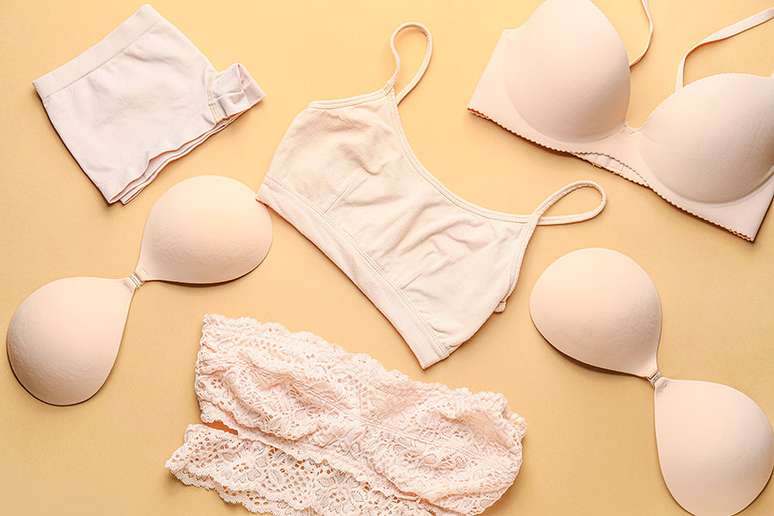Experts teach how to properly sanitize delicate items and which products can be used
html[data-range=”xlarge”] figure image img.img-c6db2fab72fba464e43170a50847d0a7a27escof { width: 774px; height: 516px; }HTML[data-range=”large”] figure image img.img-c6db2fab72fba464e43170a50847d0a7a27escof { width: 548px; height: 365px; }HTML[data-range=”small”] figure image img.img-c6db2fab72fba464e43170a50847d0a7a27escof, html[data-range=”medium”] figure figure img.img-c6db2fab72fba464e43170a50847d0a7a27escof { width: 564px; height: 376px; }
Have you ever bought lingerie and after a few uses you had to discard the garment because it was faded, deformed, with elastic problems or torn? If so, this could be related to how you sanitize them. Being garments for daily use, underwear is therefore constantly washed, making care essential during this process.
From the washing technique to the ideal drying, passing through the products, we have collected some advice from the specialists to contribute to the useful life of the garments.
Do you machine wash or hand wash your underwear? Can I use bleach? How to choose the ideal product for each fabric? These are big concerns when washing clothes.
To clarify this point, Leticia Correia, founder of the pajama and lingerie brand Intimate AVA and Marcella Zambardino, impact director and founding partner of the eco-friendly cleaning and self-care brand positiveshare 7 tips to make the items in your wardrobe last longer.
1. Follow the washing instructions
Before breaking your head thinking about the best cleaning method, the first recommendation is to pay attention to the parts label. According to Letícia Correia, underwear brands have paid more and more attention to special care recommendations for garments, including explanations of the meaning of cleaning and drying symbols on labels.
“When we go to wash a garment for the first time, we rarely follow the washing instructions. This is one of the reasons why underwear tends to last less. Before each wash, it is necessary to correctly follow the instructions found on the product label, because some delicate fabrics require special care, such as hand washing or a specific cycle, such as delicate. This also involves clarifying whether or not the piece can shed paint, requiring individual cleaning,” he explains.
2. Wash your underwear separately
To prevent underwear from being damaged by rubbing against other clothing, such as T-shirts and jeans, it’s important to wash them separately. If you can’t wash by hand or are large quantities, consider machine wash. If the machine is equipped with an agitator, it is recommended to place the parts in a cleaning bag.
“It keeps the part from rubbing against the agitator and wearing out. Another tip is to separate the pieces by fabric and color, to prevent the garment from being knitted,” Letícia points out.
3. Delicate items should be hand washed
Panties and bras with lace and silk shouldn’t be put in the washing machine, explains Letícia. Even in the most delicate cycles, these fabrics can tear, fray or deform during the stirring and spinning processes. Hand washing allows the person to have more control over scrubbing.
4. Use coconut or mild soap
“The ideal is to always wash your underwear with neutral soap, preferably ecological, as it is made directly with coconut oil, free of chlorine, artificial perfume and petroleum. This composition does not damage the skin and is safe for intimate and delicate garments, such as baby clothes, reusable sanitary pads and cloth diapers,” explains Marcella Zambardino.
Currently there are bar or powder options, which can also be dissolved in a little warm water before applying to the piece. “It’s not recommended to use the dry bar directly on a wet garment, as this can cause friction with the fabric,” he adds.
5. Special care to remove blood stains
During menstruation, some menstruating people choose to wear absorbent cloth panties or, even when using disposable pads, small drops of blood may fall on the panties. To remove stains, care must be taken in choosing the product.
Using a product that doesn’t remove stains will increase the need to scrub. A piece of advice, according to Marcella, is to combine the coconut soap with the stain remover. The ecological stain remover is made with only 2 mineral ingredients, easily removes stubborn stains and as well as being safe for delicate clothes, it is also safe for the skin”, Marcella reiterates.
“Apply the stain remover to the stained area of the underwear before washing. Gently rub the product into the stain and leave it on for a few minutes, following the manufacturer’s instructions. If the stain persists, repeat the process and leave the garments to soak for a while, then wash as usual”, comments Marcella.
6. Prefer to dry the pieces in the shade
After having cleaned the parts correctly, they must be left to dry in a dry and ventilated place.
“It is preferable to let clothes dry in the shade, direct heat from the sun can cause color fading, damage the fibers of the fabric, making underwear more prone to scratches, for example. Furthermore, even prolonged exposure to the sun can cause tissue shrinkage,” completes Marcella.
7. Store properly
The last tip is: keep your pieces well. While it seems like obvious advice, it’s not. When storing the pieces in the cabinet, fold them properly to prevent the piece from warping or joining others in the drawer.
“We know that the fashion industry is one of the most polluting in the world. When we talk about taking care of parts and extending their useful life, we are also talking about sustainability. We need to broaden this debate,” concludes Letícia.
HOMEWORK inspires transformation in the world of work, in business, in society. Created by Compasso, a content and connection agency.
Source: Terra
Ben Stock is a lifestyle journalist and author at Gossipify. He writes about topics such as health, wellness, travel, food and home decor. He provides practical advice and inspiration to improve well-being, keeps readers up to date with latest lifestyle news and trends, known for his engaging writing style, in-depth analysis and unique perspectives.






![[Coluna] Does Brazilian protectionism inspire Trump? [Coluna] Does Brazilian protectionism inspire Trump?](https://p2.trrsf.com/image/fget/cf/774/0/images.terra.com/2025/10/16/2008907400-74231636354.jpg)

